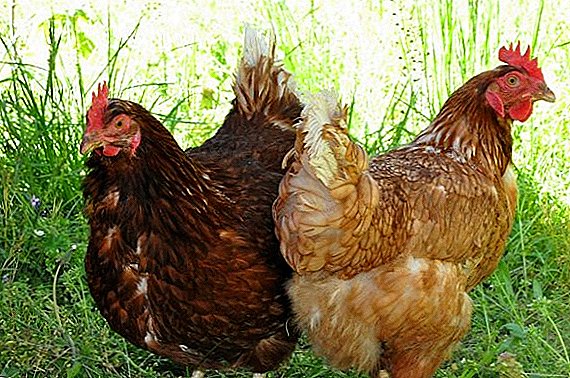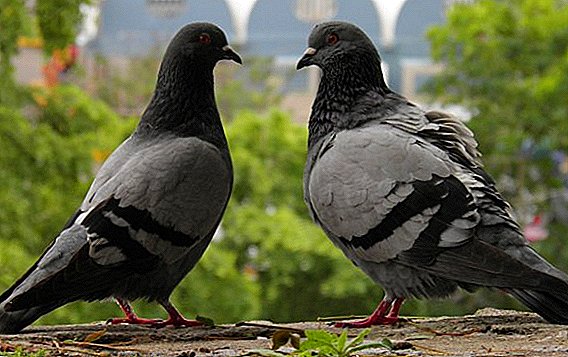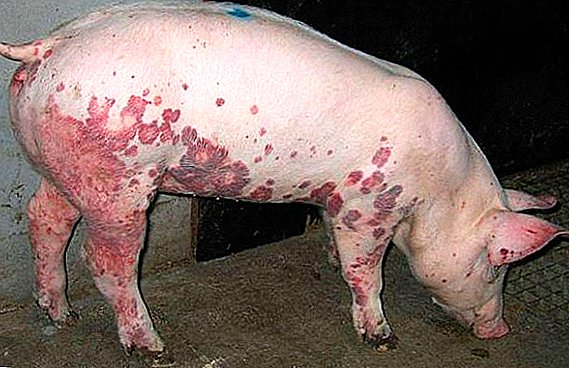 There are diseases of pigs that are not treatable and can cause the death of all individuals. Let's get acquainted with the classic swine fever, learn about its causes and symptoms, how to diagnose, what are the measures of control and prevention.
There are diseases of pigs that are not treatable and can cause the death of all individuals. Let's get acquainted with the classic swine fever, learn about its causes and symptoms, how to diagnose, what are the measures of control and prevention.
What is this disease
Classical swine fever is diagnosed in different parts of the world where they live.
Description
This disease causes the virus. All species of both domestic and wild pigs suffer from it. It is very contagious and hard flowing. It is characterized by fever, inflammation of the colon mucosa, affects the circulatory and hematopoietic system.
Did you know? Man domesticated pigs for 8 thousand years before the beginning of our era. It happened on the territory of modern China.
Mortality
The probability of death in classical swine fever is high - from 80 to 100%. In addition, there is no treatment against it, and sick pigs go for slaughter. In very rare cases, antiviral and anti-inflammatory drugs are used. The recovered animal acquires lasting immunity to this plague.
Danger to humans
The transmission of this viral disease from pigs to humans or other animals has never been diagnosed. But the people themselves may be the source of the disease for the pigs, as a result, separate clothes are used for the pigs in order not to carry the infection. For the destruction of the virus in the meat of sick animals need a long heat treatment, so do not recommend to use fat and smoked meats from the outbreaks of epidemics of classical swine fever.

A person who has eaten an under-processed product, as we have said, will not get sick, but may infect pigs. Another reason not to eat such a product or to treat it well is that the virus mutates periodically, and the possibility that it will ever become dangerous for humans should not be ruled out.
Causative agent and source of infection
The culprit of the disease refers to the Togavirus, in which ribonucleic acid is in the protein capsid. When a pig is infected, the virus spreads through the blood and all tissues of the body, infecting all organs.
Also read what diseases have domestic pigs.
There are 3 types of virus that causes classical swine fever:
- Type A. Causes acute plague leakage.
- Type B. Infection is characterized by chronic or atypical forms of the disease.
- Type C. This is a slightly contagious variety, based on which vaccines are being developed.
All types are stable and die within an hour at a temperature of + 70 ... + 80 ° C or under the chemical action of some compounds. The pathogen is contagious, and infection can occur in a variety of ways - through contaminated food and drink, through the respiratory system or damaged skin.

Usually, outbreaks of epidemics are recorded in the fall, and the virus of this plague reaches the pigs through contaminated food and water, bedding and feces. It is introduced by rodents or other possible carriers (other pets, attendants, worms). Frequent factor of infection is ingestion or storage in the farm meat contaminated individuals.
Did you know? About one hundred breeds of pigs are now known. Mostly large white breeds are bred in the Russian territory - about 85%.
Symptoms and course of the disease
You need to know the symptoms of this dangerous for swine plague, in order to identify it in time and to take the necessary measures to prevent an outbreak of the epidemic. The disease can occur in different forms. The incubation period often lasts 3-7 days, but can sometimes last up to 21 days.

Sharp
The acute course of the disease has the following symptoms:
- fever up to 40.5-42.0 ° C, chills;
- pigs are trying to bury themselves in the litter and warm themselves;
- lack of appetite;
- the appearance of thirst;
- vomiting begins;
- constipation is replaced by diarrhea;
- inflammation of the eyes with purulent formations, eyelids;
- there are cuts on the hind legs;
- dark urine;
- bubbles appear on the skin with a yellowish liquid, hemorrhage;
- nasal inflammation and bleeding begin;
- ears, nose and tail become bluish;
- before death the body temperature drops to 35-36 ° C.
Important! Most quickly, the classical plague occurs in piglets that die within the first few days of infection. In this case, the first symptom that attracts attention is the vomiting of infected young animals.
Subacute
In this form, it takes about 20-22 days from identifying the disease to the death of the pigs.
The signs of a subacute form of infection are as follows:
- sharp weight loss;
- eyes and nose are inflamed, pus runs out of them;
- diarrhea with a sharp unpleasant odor;
- coughing up
Chronic
It is observed on farms where pigs were vaccinated, but the rules for care, maintenance and feeding were not followed. Initially, weaker animals begin to hurt, but then the disease spreads. The disease occurs in a relatively light form and lasts about 60 days.

Infected individuals show the following signs of infection:
- coughing up;
- loss of appetite;
- skin rashes;
- total depletion of the body.
Pigs who have recovered in this form of CSF are carriers of the pathogen for a year. The chronic course of the disease greatly weakens the body and reduces productivity.
Pathological changes
The following pathological changes are present in the dead animals of CSF:
- on the skin a lot of hemorrhages of different forms;
- lymph nodes of hypertrophied form, have dark red color, marbling is observed in the section;
- light spotty;
- on the heart muscle there are hemorrhages;
- the spleen is hypertrophied, and along its edges there are traces of heart attacks, which is one of the main signs of the presence of CSF;
- the kidneys are pale with hemorrhages;
- gastrointestinal mucosa hyperemic;
- if the animal's death occurred in its acute form, then typical buds from the plague can be identified.
Did you know? Heat in pigs goes mainly through the mucous membranes and is regulated by more frequent breathing. Swine penny is the only surface on their body that can sweat.
Diagnostic methods
The diagnosis of classical plague is based on clinical, epidemiological, pathological, biological, and laboratory data from studies conducted by sanitary and veterinary services. Its symptoms are inherent in other diseases - African plague, pasteurellosis, salmonellosis, Aujeszky's disease, influenza, erysipelas, anthrax, and some poisonings, so take note of the results of all analyzes and factors.

Laboratory studies include work on the isolation of the virus in the culture of cells RK-15, serological identification by immunofluorescence and RNGA, make biological samples on unvaccinated young. Spleen, lymph nodes, blood and bone marrow are sent to studies only of dead or slaughtered individuals. For the detection of antibodies to the pathogen, blood is examined with the help of PHAA and ELISA immunoelectrophoresis.
Control measures
Unfortunately, the effective treatment of animals that have identified this disease has not yet been developed. This disease is very contagious, so when quarantine is detected on the farm, quarantine is introduced. All infected animals on small farms are given for slaughter, and then disposed of (burned).  Healthy individuals are vaccinated without fail. At large enterprises for growing pigs produce slaughter, followed by processing on the stew. Pork carcasses, unsuitable for processing for the food industry, are given for processing for the production of meat and bone meal.
Healthy individuals are vaccinated without fail. At large enterprises for growing pigs produce slaughter, followed by processing on the stew. Pork carcasses, unsuitable for processing for the food industry, are given for processing for the production of meat and bone meal.
Introduce general restrictions on the recommendations of the sanitary services, which are used for other infectious diseases. It is possible to remove quarantine from dysfunctional pig farms for CSF only 30-40 days after slaughter or death of the last sick animal. After that, it is necessary to conduct a thorough disinfection of all premises, buildings, equipment and tools that have been in contact with pigs. After the cancellation of the quarantine for 3 years in a row, all animals are vaccinated against CSF without fail.
Prevention
A disease like classical swine fever is better prevented than the aftermath.
Important! At the first sign of detection of CSF, contact the appropriate sanitary and veterinary services.
General measures
To prevent the occurrence of classical swine fever on pig farms Veterinary services recommend such preventive measures:
- Keep quarantine for acquired piglets and adult individuals. For this, they are kept separate from the main herd for about 30 days. If after this time there are no signs of the disease and the animals have been immunized, then they can be allowed to the main herd.
- All tools, devices, workers' clothing, bedding, and vehicle for transportation must be disinfected. Food, drink, drinkers and feeders must be kept clean and disinfected.
- It is imperative to provide a reliable fence that protects from visiting the farm of animals that are carriers of the plague pathogen (cats, dogs, martens, rats).
- Take measures to fight rodents, as mice and rats are carriers of various infections.
Vaccination
The most effective preventive measure is vaccination of pigs against classical plague. This procedure produces immunity against this disease. For this purpose, apply 4 vaccines for CSF. The vaccination process is carried out 1 time in 12 months.  100% of this vaccination will not be able to protect pigs from the appearance of infection, but if the infection still occurred, then the disease often takes an atypical, that is, easier form. It should be noted that this vaccination does not affect the offspring at all during the procedure for sows.
100% of this vaccination will not be able to protect pigs from the appearance of infection, but if the infection still occurred, then the disease often takes an atypical, that is, easier form. It should be noted that this vaccination does not affect the offspring at all during the procedure for sows.
Classical plague is very dangerous for the entire livestock of pigs. In the areas of risk, vaccines should be given to all livestock and always follow sanitary and hygienic requirements, including proper disposal of sick animals.












